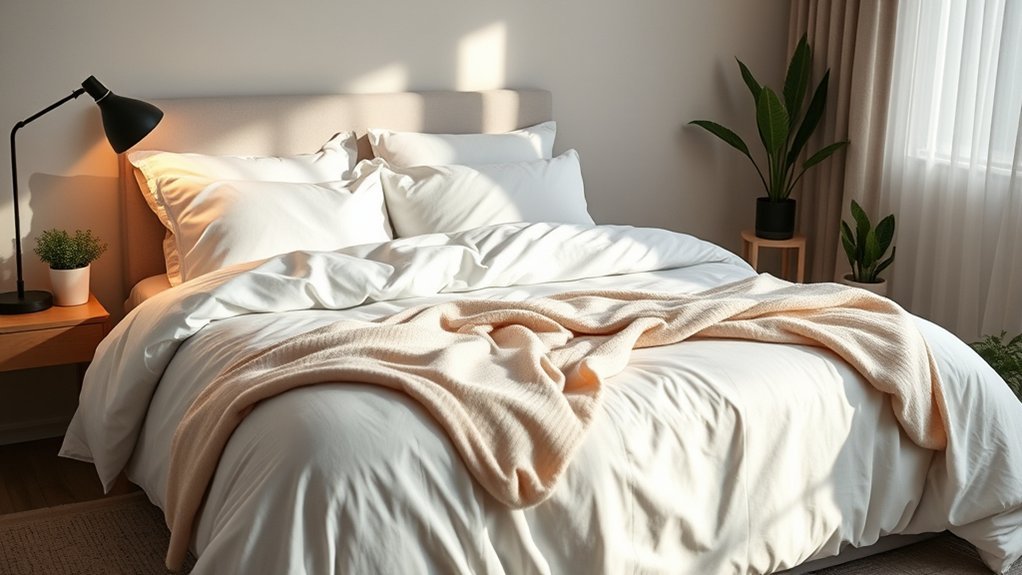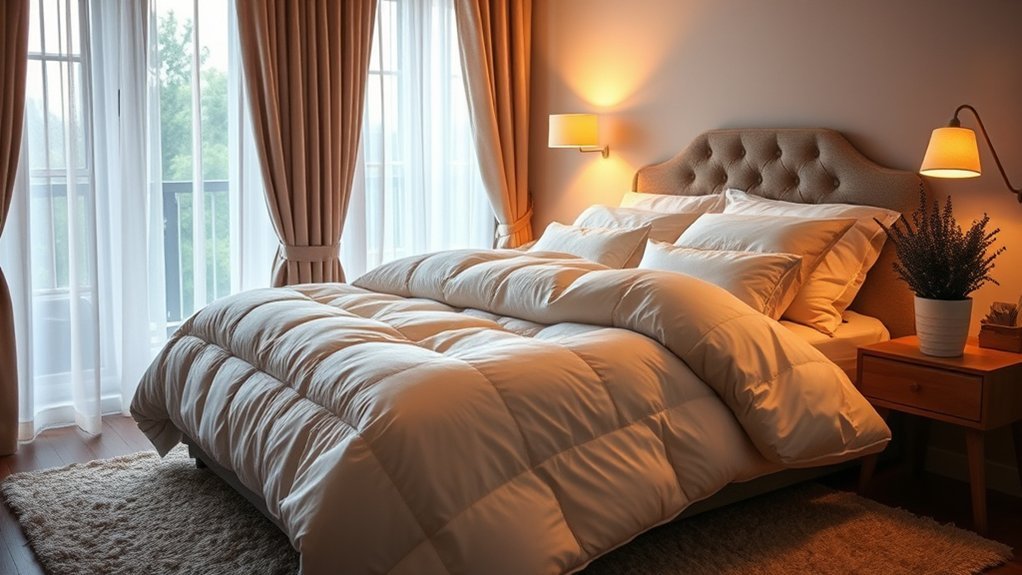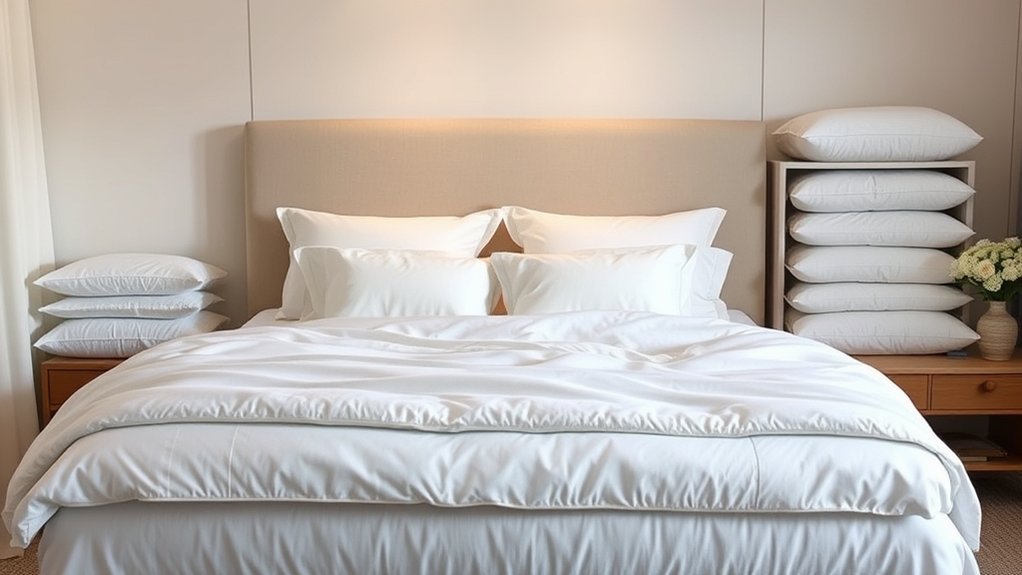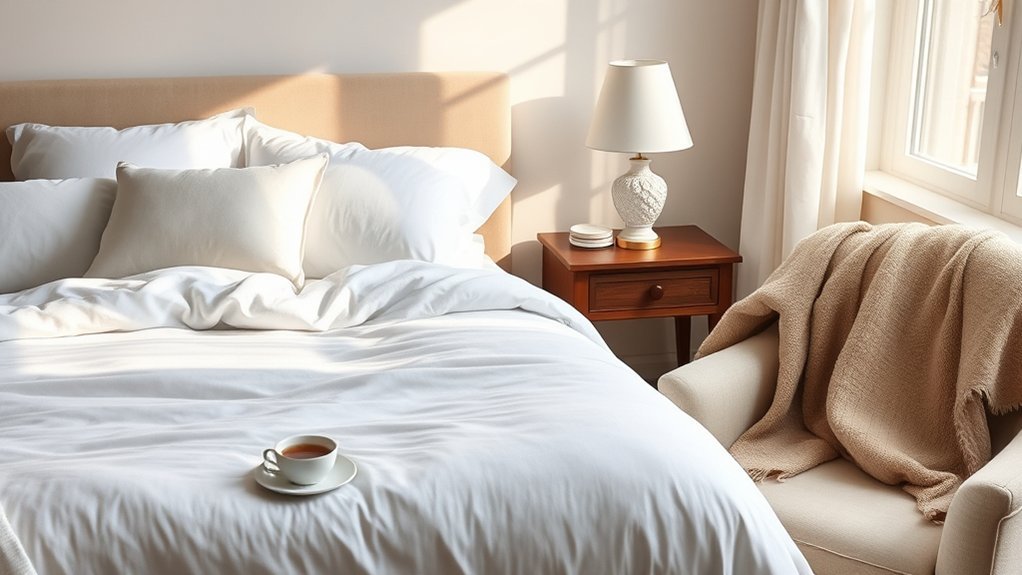You know how important sleep comfort is for your overall well-being. It’s not just about getting enough hours; it’s about the quality of that sleep. By making small adjustments to your environment and habits, you can greatly enhance your rest. Have you considered how your bedroom setup might be affecting your sleep? Let’s explore the essential steps you can take to guarantee you wake up refreshed and ready for the day ahead.
Understanding the Importance of Sleep Comfort

When you prioritize sleep comfort, you’re investing in your overall well-being. Quality sleep directly affects your mood, productivity, and health. A comfortable sleep environment helps your body recover, strengthens your immune system, and enhances cognitive function.
When you sleep well, you’ll likely experience improved emotional resilience, allowing you to handle daily stressors more effectively.
Neglecting sleep comfort can lead to restless nights and fatigue, which can hinder your performance and relationships. You deserve to wake up refreshed and energized.
Neglecting sleep comfort results in fatigue and restless nights, affecting your performance and relationships. Wake up refreshed and energized.
Assess your mattress, pillows, and bedding, ensuring they support your body properly. Remember, investing in sleep comfort isn’t just about luxury; it’s a fundamental step toward a healthier, happier life.
Prioritize your sleep—it’s essential for thriving.
Setting the Right Sleep Environment

To create the perfect sleep environment, it’s essential to focus on the ideal room temperature, lighting, and noise control.
You’ll find that a cool, dark, and quiet space greatly enhances your ability to fall and stay asleep.
Optimal Room Temperature
Creating the right sleep environment starts with setting an ideal room temperature, as a comfortable climate can greatly impact your ability to drift off and stay asleep.
Aim for a temperature between 60 to 67 degrees Fahrenheit (15 to 19 degrees Celsius). This range promotes the natural drop in body temperature that signals it’s time for sleep. If it’s too hot or too cold, your body may struggle to relax, leading to restlessness.
Consider using fans or adjusting your thermostat to achieve this balance. Additionally, invest in breathable bedding materials like cotton or linen to enhance your comfort.
Lighting and Noise Control
A well-lit room can either lull you into sleep or keep you tossing and turning through the night. To create your ideal sleep environment, aim for soft, warm lighting that mimics the sunset. Dimmable lamps or smart bulbs can help you adjust brightness as bedtime approaches.
Block out unwanted light with blackout curtains or an eye mask to signal to your body that it’s time to wind down.
Noise control is equally essential. Use white noise machines or fans to drown out disruptive sounds, or consider earplugs if you’re in a particularly noisy area.
Choosing the Perfect Mattress and Pillows

When it comes to sleep quality, choosing the right mattress and pillows is essential for your comfort and support.
You’ll want to explore different mattress types and understand how pillow materials can impact your sleep experience.
Mattress Types Explained
Choosing the right mattress and pillows is essential for a good night’s sleep, as it directly impacts your comfort and overall health.
When it comes to mattress types, you’ve got options. Innerspring mattresses provide excellent support and a traditional feel, while memory foam contours to your body, relieving pressure points.
Latex mattresses are durable and offer a responsive bounce, ideal for those who change positions frequently. Hybrid mattresses combine the best of both worlds, balancing support and comfort.
Don’t forget about firmness levels; it’s vital to match your sleeping position with the right firmness. Whether you’re a side, back, or stomach sleeper, understanding these options helps you make an informed choice, ensuring you wake up refreshed and ready for the day.
Pillow Materials Comparison
Finding the perfect pillow can greatly enhance your sleep experience, and understanding the various materials available is key to making the right choice.
Each material offers unique benefits that cater to different sleep preferences.
- Memory Foam: Contours to your head and neck, providing excellent support and pressure relief.
- Latex: Naturally resilient, it offers a bouncy feel while being breathable and durable.
- Down: Luxuriously soft and lightweight, offering a plush feel but may not provide enough support for some.
Consider your sleeping position and any allergies you may have when selecting.
The right pillow can make a significant difference in your comfort and overall sleep quality, ensuring you wake up refreshed and ready to tackle the day.
Size and Firmness Matters
A pillow’s material and construction are just part of the equation; size and firmness play a pivotal role in your overall sleep experience. Choosing the right mattress and pillows requires careful consideration of these factors.
| Size | Firmness Level | Recommended For |
|---|---|---|
| Standard | Soft | Side sleepers |
| Queen | Medium | Back sleepers |
| King | Firm | Stomach sleepers |
| Travel | Adjustable | All types |
| Body | Extra Firm | Larger individuals |
Selecting the proper size guarantees that your head and neck are well-supported, while firmness affects spinal alignment. Take the time to experiment, as the right combination can greatly enhance your sleep quality. Prioritize comfort; you deserve restful nights.
Establishing a Consistent Sleep Schedule
While it might seem challenging to stick to a sleep routine, establishing a consistent sleep schedule is essential for your overall well-being. Regular sleep patterns help regulate your body’s internal clock, leading to better rest and rejuvenation.
Here are a few key benefits to take into account:
- Improves your mood and cognitive function
- Enhances your immune system
- Reduces the risk of chronic health issues
To create your schedule, pick a bedtime and wake-up time that you can stick to every day, even on weekends. This consistency reinforces your body’s natural rhythms, making it easier to fall asleep and wake up feeling refreshed.
Creating a Pre-Sleep Routine
Creating a pre-sleep routine can greatly enhance the quality of your rest, as it signals your body that it’s time to wind down. Start by setting aside 30 minutes before bed for calming activities. This could include reading, gentle stretching, or practicing mindfulness. Consistency is key; doing the same activities nightly helps reinforce your body’s sleep signals.
Here’s a simple table to guide your routine:
| Activity | Duration |
|---|---|
| Unplug Devices | 10 mins |
| Relax with a Book | 15 mins |
| Gentle Stretching | 5 mins |
Managing Light and Noise Levels
Managing light and noise levels in your sleeping environment is essential for achieving restful sleep. A peaceful atmosphere can greatly enhance your sleep quality.
Here are some effective strategies to keep in mind:
- Block out light: Use blackout curtains or an eye mask to reduce unwanted light exposure, especially during early mornings or late evenings.
- Control noise: Employ earplugs or a white noise machine to minimize disruptive sounds that can interrupt your slumber.
- Choose calming colors: Opt for soft, muted colors in your bedroom decor, which can create a serene ambiance conducive to relaxation.
Incorporating Relaxation Techniques
Once you’ve set the stage by controlling light and noise, the next step is to incorporate relaxation techniques that prepare your mind and body for sleep.
Start by practicing deep breathing; inhale slowly through your nose, hold for a moment, and exhale gently through your mouth. This calms your nervous system and reduces anxiety.
You might also try progressive muscle relaxation, tensing and then relaxing each muscle group from your toes to your head.
Mindfulness meditation can be beneficial too; focus on the present moment and let go of racing thoughts.
Consider gentle yoga stretches to release tension.
Evaluating and Adjusting Your Sleep Strategy
How do you know if your current sleep strategy is effective? Start by evaluating key indicators of sleep quality. If you’re struggling to rest well, it might be time to adjust your approach.
Evaluate your sleep quality to determine if your current strategy is effective and adjust as needed for better rest.
Consider these factors:
- Sleep Duration: Are you consistently getting 7-9 hours of sleep?
- Sleep Quality: Do you wake up refreshed or groggy?
- Daytime Functionality: Are you alert and productive during the day?
If you notice any red flags, make small changes to your routine. Experiment with bedtime consistency, create a calming pre-sleep environment, or limit screen time before bed.
Frequently Asked Questions
How Does Diet Affect Sleep Comfort and Quality?
Your diet greatly impacts sleep comfort and quality. Consuming heavy, spicy meals or caffeine close to bedtime can disrupt your rest. Instead, focus on balanced nutrition and lighter meals to promote better sleep patterns and overall well-being.
Can Exercise Help Improve Sleep Comfort?
Absolutely, exercise can work wonders for your sleep comfort. By boosting your mood and reducing stress, it helps you drift off easier. Just remember, timing’s key—avoid vigorous workouts close to bedtime for best results.
What Role Does Stress Play in Sleep Comfort?
Stress negatively impacts your sleep comfort by triggering anxiety and racing thoughts, making it hard to relax. Managing stress through techniques like mindfulness or deep breathing can greatly enhance your ability to achieve restful sleep.
Are Sleep Supplements Effective for Enhancing Comfort?
Sleep supplements can be effective for enhancing comfort, but their efficacy varies. You should consult a healthcare professional to understand the right options for your needs, ensuring they align with your overall health and wellness.
How Often Should I Replace My Mattress for Optimal Comfort?
You should replace your mattress every 7 to 10 years, as studies show that 70% of people experience improved sleep quality with a new mattress. Regularly evaluating your comfort can enhance your overall well-being considerably.
Conclusion
In the quest for sleep comfort, a few small changes can lead to big improvements. You might struggle with restless nights while dreaming of peaceful slumber, but by following these steps, you can transform your sleep experience. As you create a serene environment, embrace a consistent schedule, and incorporate relaxation techniques, you’ll find yourself drifting off more easily. Remember, prioritizing sleep isn’t just a luxury; it’s an essential part of your well-being. Sleep well, live well!
